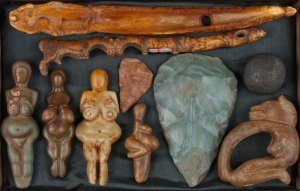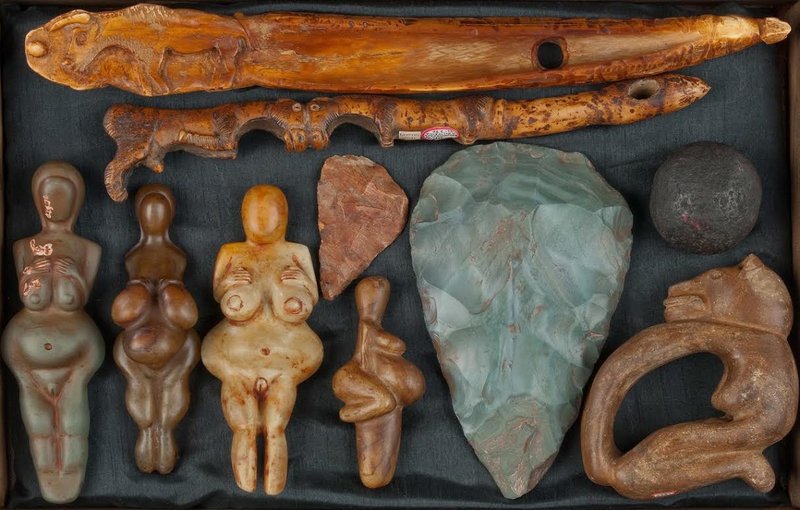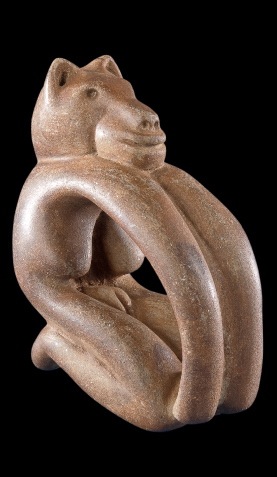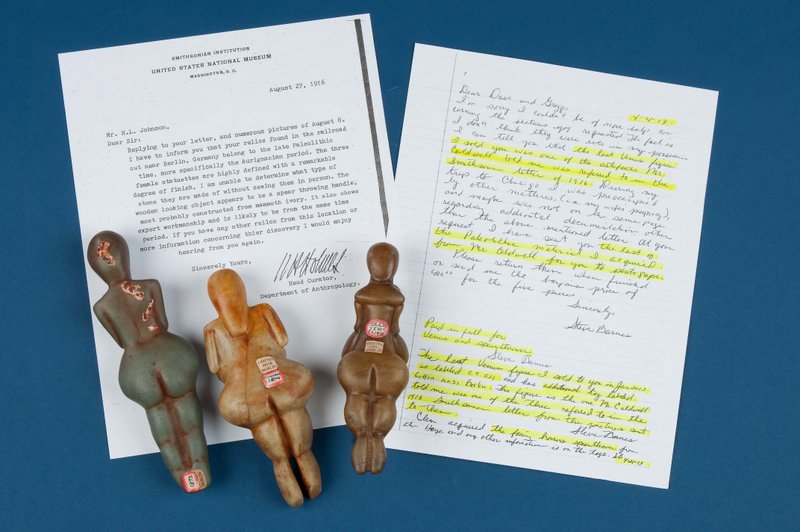
It is rare to see so many prehistoric art objects collected in one assemblage—especially if they are all authentic. But that has been the key question for everyone who has seen and handled the objects of the “Berlin Collection”, a grouping of what appear to be ancient Paleolithic figurines and other artifacts that some scholars have, at first blush, thought to be “too perfect” to be true.
They are masterly crafted and well-preserved, to be sure, but it has nothing to do with whether they are real or fake. That determination has to be made by experts and scientists specially trained and experienced in the science and techniques required to come to a sound conclusion. And this has been the journey for retired neuropsychiatrist Gregg Miklashek, the collector who acquired and compiled them in a salvage effort for further study for no less than $100,000 through an antiquities dealer and archaeologist. At one time they were part of the private collections of Clem Caldwell and Earl Townsend, two well-known Native American artifact collectors, now deceased. Before that, they were residing among the voluminous collections of the Heye Foundation in New York City for three decades. The artifacts were catalogued in Townsend’s notes as having been discovered (presumably by workmen) in a river bank outside of Berlin (hence the “Berlin Collection”) in 1870 while excavating a railway cut.
Now Miklashek, the latest owner of the collection, has donated them to the Logan Museum of Anthropology at Beloit College in Beloit, Wisconsin, where they will reside as part of the museum’s permanent collection and where they will be the subject of continuous study and examination. The objects include a handful of “Venus” red limestone, red sandstone, greenstone, calcite and gem serpentine figurines resembling in style the famous Venus of Willendorf found in Austria in 1908; a biotite mica schist ‘lion goddess’ figurine; and two spearthrowers, one made of mammoth ivory and the other antler.
“My intention was to reconstruct the original complete collection and research it, which I accomplished over a 6-year period,” says Miklashek. “Three figurines and the mammoth ivory spearthrower are known in an August 27, 1916 letter from W. H. Holmes, then Curator of Anthropology at the Smithsonian Institution, to H. L. Johnson [a collector who brought the artifacts to Holmes’ attention].” In that letter Holmes stated that the artifacts appeared to “belong to the late Paleolithic time, more specifically the Aurignacian period.”
__________________________________________
 The Berlin Collection. Image provided courtesy of Greg Miklashek
The Berlin Collection. Image provided courtesy of Greg Miklashek
_______________________________________
 The Paleolithic ‘Lion Goddess’ of the Berlin Collection. “Too perfect” to be real? Miklashek notes that “this item is described as having been found in a cave in the Schwabian Alps of southern Germany, as was the Lion Man of Ulm“. Courtesy Gregg Miklashek and John Stickney of Allied Art and Photography.
The Paleolithic ‘Lion Goddess’ of the Berlin Collection. “Too perfect” to be real? Miklashek notes that “this item is described as having been found in a cave in the Schwabian Alps of southern Germany, as was the Lion Man of Ulm“. Courtesy Gregg Miklashek and John Stickney of Allied Art and Photography.
_______________________________________
 Three of the ‘Venus’ figurines of the Berlin Collection, shown with documentation connected with the research history. The document on the left is the Holmes letter. Image provided courtesy of Gregg Miklashek
Three of the ‘Venus’ figurines of the Berlin Collection, shown with documentation connected with the research history. The document on the left is the Holmes letter. Image provided courtesy of Gregg Miklashek
_______________________________________
But the long road to determining their authenticity, age and true cultural attribution has been a frustrating one for Miklashek. A series of preliminary studies or tests by a variety of experts on the artifacts never reached full fruition, but not because they were ever confirmed to be modern forgeries. The fact that the objects were obtained on the antiquities market and not from a controlled archaeological excavation has been one roadblock to serious additional consideration. For Miklashek and others who still see some value and information to be gained from ancient objects ‘tainted’ because of their lives on the antiquities market, this represents lost opportunity for research. “This is a delicious mystery story and the final outcome may never occur,” he says. “How much more valuable archaeological material remains in private collections is an important question never asked by academic archaeologists. I guess, if they didn’t find it, it can’t be real.”
For his part, Miklashek, though not an archaeologist, has completed extensive study and research on his own. He has his own theory about the objects.
“They could be 100-year-old forgeries,” he states, “although none of the examining archaeologists believed this to be possible, given the paucity of archaeological knowledge of such objects and their construction in 1916 [the year of the Holmes letter about the artifacts]. I believe these objects, described and cataloged in Earl Townsend’s collection notes as having been found in a river bank outside Berlin c. 1870, represent Epi-gravettian material left by previously unknown Gravettian hunter-gatherers returning north after the retreat of the last lobe of the Weichselian glaciation from the future location of Berlin,” he states. “As the mammoth ivory spearthrower using C14 AMS dated at 15,000 yrs. BP at the University of Illinois, I believe the material to have been buried at that time.”
Dr. William Green, who is the James E. Lockwood, Jr., Director of the Logan Museum of Anthropology and a professional anthropologist, will now oversee the artifacts with a fresh start. His objectives for the collection will revolve around student education and further study and research.
“The objects and the associated documentation can help students learn about various analytical methods including stylistic, material composition, and dating, and can also be used to help them understand how manufacturing techniques can be studied,” he says. “In addition, students can learn about archival research and may even be involved in researching primary sources in Germany. All of this work will be oriented toward learning as much as possible about the history and provenance of the objects, building on the work Dr. Miklashek has already conducted.”
Finally, says Green, “the objects will be exhibited so visitors can appreciate them and learn about the ongoing analyses, even though conclusive statements regarding age are not yet possible.”
More information about the Logan Museum of Anthropology can be obtained at the museum website.
___________________________________________________
 You can read our more in-depth articles about new discoveries and developments in archaeology and anthropology with a premium subscription to Popular Archaeology Magazine. Find out what Popular Archaeology Magazine is all about.
You can read our more in-depth articles about new discoveries and developments in archaeology and anthropology with a premium subscription to Popular Archaeology Magazine. Find out what Popular Archaeology Magazine is all about.
In addition, the latest Popular Archaeology ebook is now available.
______________________________________________
Travel and learn with Far Horizons.
____________________________________________
 Popular Archaeology’s annual Discovery Edition eBook is a selection of the best stories published in Popular Archaeology Magazine in past issues, with an emphasis on some of the most significant, groundbreaking, or fascinating discoveries in the fields of archaeology and paleoanthropology and related fields. At least some of the articles have been updated or revised specifically for the Discovery edition. We can confidently say that there is no other single issue of an archaeology-related magazine, paper print or online, that contains as much major feature article content as this one. The latest issue, volume 2, has just been released. Go to the Discovery edition page for more information.
Popular Archaeology’s annual Discovery Edition eBook is a selection of the best stories published in Popular Archaeology Magazine in past issues, with an emphasis on some of the most significant, groundbreaking, or fascinating discoveries in the fields of archaeology and paleoanthropology and related fields. At least some of the articles have been updated or revised specifically for the Discovery edition. We can confidently say that there is no other single issue of an archaeology-related magazine, paper print or online, that contains as much major feature article content as this one. The latest issue, volume 2, has just been released. Go to the Discovery edition page for more information.
____________________________________________







